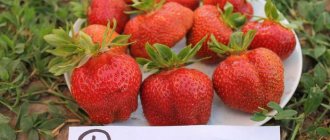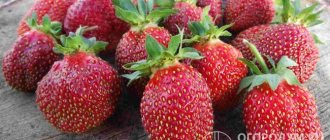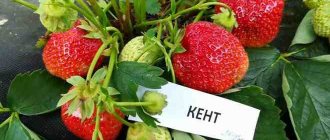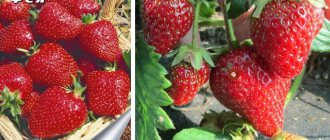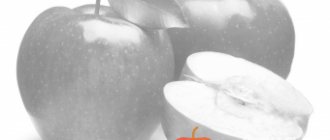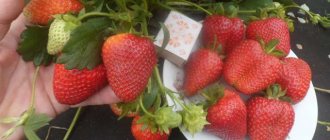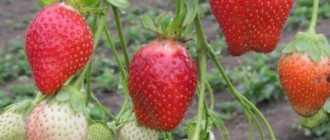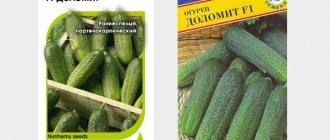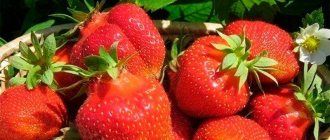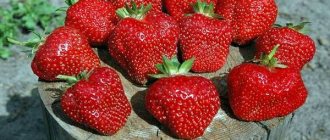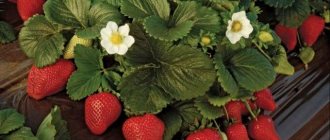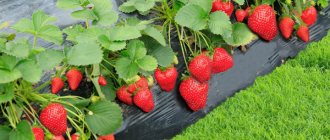Characteristic
Strawberry Irishka is quite popular among those who like to cultivate berry crops in their garden plots. Early ripening, long-term fruiting, high yield and the ability to grow in any climatic conditions are the main characteristics of the Irishka variety.
The first berries appear in early June. Fruiting continues until frost occurs. The last fruits are harvested in October.
The average weight of berries is 25 g. From one plant of this variety, up to 2 kg of fruit can be harvested over the entire season, provided that agricultural conditions are properly observed.
Distinctive features
The Irishka variety forms compact bushes of medium size and up to 30 cm in height. The leaves are rich green.
There are a huge number of flower stalks. They are located approximately at the same level with the foliage. The berries of the Irishka strawberry grow quite tasty, aromatic, dark red in color and cone-shaped. The pulp inside the fruit is juicy and sweet. The Irishka variety does not form a mustache, which makes care much easier.
What to look for when choosing strawberries for planting
The territory of the Urals is vast, the climate of the southern regions differs from the northern regions. But in general the region is characterized by:
- distance from the oceans, location in the interior of the continent;
- combination of different types of climate (mountain, continental);
- the presence of a natural barrier - the Ural Mountains;
- long, harsh winters and short, cool summers in the north;
- short winter period and long summer - in the south;
- uneven distribution of humidity zones and solar radiation.
To get high yields in the Trans-Ural and Urals regions, you will have to work hard. Therefore, when choosing a variety, take into account:
- frost resistance of the plant. During cold weather, soils freeze to a considerable depth; shelters are indispensable;
- resistance to fungal and bacterial infections (especially rot). In the Urals, there is often constant precipitation in the second half of summer and early autumn, and there is an excess of moisture in the soil. In such conditions, varieties resistant to infections and viruses feel better;
- ripening time. It is advisable to choose early and mid-season strawberries, which have time to produce the bulk of the harvest in the first half of summer.
Remontant varieties are grown in the Urals, as well as day-neutral strawberries. But for such varieties with their late fruiting, additional shelters are provided or the crop is planted in greenhouses (greenhouses, tunnels).
Sowing
Since the Irishka variety does not throw away its mustache, strawberries are propagated by sowing seeds for seedlings. Irishka seeds have a 50% germination rate, so compliance with sowing rules plays an important role. Sowing of seedlings is carried out from the beginning of February until April in containers with prepared soil mixture. The soil for sowing seedlings is prepared with the following composition:
- 3 parts good humus;
- 2 parts of garden soil (crumbly, without lumps or roots);
- 1 part peat from the store.
Fill 10 cm of seedling boxes with this mixture and disinfect them with a weak solution of potassium permanganate. Then, using a ruler, at a distance of 4 cm, draw grooves 3 cm deep, and lay strawberry seeds in them at intervals of 2 cm. Do not sprinkle the seedlings with soil. Cover the boxes with plastic wrap and place them in a warm place, with a temperature of at least 22 degrees Celsius.
Watering is done very carefully, using a spray bottle or syringe, making sure that the seeds are not washed off the surface of the soil base. The film must be removed to ventilate the seedlings for several hours, preventing condensation from appearing on its surface. When shoots appear, the film is removed.
When two true leaves appear on the sprouts, the strawberry seedlings are planted in separate cups or peat tablets.
When the seedlings produce 5-6 good leaves, the strawberries are ready to be planted in open ground.
Advice for beginning gardeners and strawberry lovers
Strawberry seeds are small and hard to germinate. Not all gardeners have a successful first sowing experience. Possible reasons for “failure”: the initial low quality of the seeds, drying out already swollen seeds, or planting too deep. The optimal seeding depth is 2–3 times the diameter of the seed itself (approximately 3–5 mm). But a certain sleight of hand is required to comply with this requirement, especially if there are a lot of seeds. In addition, when the soil is not compacted enough, watering can cause the seeds to sink deeper, which will damage them. There are several techniques that can increase your chances of success. They may come in handy if you are sowing strawberries for the first time or if you have bought expensive seeds of a valuable variety. Pre-germination – allows you to control seed germination. The seeds are soaked for two to three days in snow or rain water (in a tea saucer), changing it twice a day. At the same time, germination inhibitors in strawberry seeds, which slow down the growth of the embryo, are destroyed. Strawberry seeds, swollen after soaking, are placed in a thin layer on filter or toilet paper placed on a saucer. The paper is soaked in water and the excess is drained. The saucer with strawberry seeds is placed in a whole plastic bag, placed in a warm place in the light (but not in the sun, otherwise you will have to add water often). As soon as the seeds hatch, we take each seed using a sharpened match and plant it in a box filled with loose sifted soil. Sowing in snow reduces the risk of deepening and promotes uniform germination. Snow is laid on top of the substrate prepared for sowing in a layer of 1 cm. Seeds are laid out on the snow and allowed to melt. With melt water, the seeds are slightly drawn into the soil. After this, there is no need to straighten, sprinkle with soil or bury even the seeds remaining on the surface - strawberries germinate both in the dark and in the light. Cover the container with glass or film and keep it in a bright window, ventilating it daily and moistening it with a sprayer if necessary.
picking strawberry seedlings
Stratification – ensures faster, more friendly and stronger shoots. The container with the sown and moistened seeds is kept in the refrigerator for 3–4 weeks, then placed in a warm place for germination.
Go to the main article about strawberries (garden strawberries)
Landing
To plant the Irishka strawberry variety on a personal plot, you need a place with standard conditions typical for growing any variety:
- 1Maximum sunlight exposure.
- The soil type is neutral or slightly acidic.
- No effect of through winds.
- The depth of groundwater is at least 1 meter to the surface.
The bed for strawberries is prepared in advance. The land is cleared of weeds, dug up and organic and mineral fertilizers are applied. Rotted manure (one bucket per square meter) and wood ash (200 g per 1 sq. m) are optimal for preliminary preparation.
Strawberry seedlings are planted using the following planting scheme:
- between seedlings – 30 cm;
- between rows – 70 cm;
- the location of the beds is from north to south.
This scheme is favorable for the free growth of strawberries.
Strawberries are planted in moistened holes. The soil around the bushes must be compacted and care must be taken to ensure that the root collar of the plant is not covered with soil. Each strawberry seedling must be watered abundantly. Watering the planted strawberries is carried out approximately once every two days until the seedlings take root.
After planting, the Irishka strawberry needs regular care, which includes simple rules:
- Timely watering.
- Loosening.
- Weeding.
- Application of fertilizers.
Strawberries should be watered approximately once every 2 weeks, depending on weather conditions. Dry soil will adversely affect the harvest. But you shouldn’t pour strawberries either.
After moistening, the next day, the soil under the bushes is loosened in order to remove the hard earthen crust that prevents the access of oxygen to the root system. Weeds must be removed as they grow.
Mulching the beds with hay, grass, sawdust, straw or black fiber is a significant relief in caring for strawberries. Mulch prevents the formation of weeds in the garden bed and retains moisture in the soil for a longer period.
Care
After planting, the Irishka strawberry needs regular care, which includes simple rules:
- Timely watering.
- Loosening.
- Weeding.
- Application of fertilizers.
Strawberries should be watered approximately once every 2 weeks, depending on weather conditions. Dry soil will adversely affect the harvest. But you shouldn’t pour strawberries either.
After moistening, the next day, the soil under the bushes is loosened in order to remove the hard earthen crust that prevents the access of oxygen to the root system. Weeds must be removed as they grow.
Mulching the beds with hay, grass, sawdust, straw or black fiber is a significant relief in caring for strawberries. Mulch prevents the formation of weeds in the garden bed and retains moisture in the soil for a longer period.
Feeding
Fertilizing of the remontant variety Irishka is necessary to saturate the soil base with nutrients. Before flowering and after picking the berries, you need to feed the strawberries with fertilizers containing nitrogen. Solutions of urea, chicken manure (1:20), or mullein (1:10) are excellent for feeding.
Minerals are necessary for plants, so the application of mineral fertilizers is also required for the Irishka variety.
Remontant strawberries devote a lot of energy to flowering and fruiting all season long, so a lot of feeding is required. During the summer it is recommended to make up to 10 feedings.
To prepare for winter, complex fertilizers without nitrogen are applied. Plants need nitrogen only during the growing season.
Good large-fruited Lord variety
This is a variety of large-fruited strawberry, which was obtained by English breeders. In terms of ripening, it is classified as late. At the same time, the duration of fruiting is long. Every year the amount of harvest only increases.
You can grow bushes in one place for several years. The weight of one berry will be 60 g.
Strawberries are blunt-conical in shape and have a rich red color. Their taste is also pleasant, with slight sourness. About 6 berries are concentrated on one peduncle. The variety is high-yielding.
The Lord variety is characterized by strong immunity to diseases such as gray rot. This is due to the fact that the surface of the strawberry is dry and does not contact the ground. The harvested crop is perfectly stored, transported and does not lose its presentation for 3 days.
If the weather is sunny, the berries retain their excellent taste. But during rain, the concentration of sugars decreases. The Lord variety is self-pollinating and winter-hardy. For high fruiting it is necessary to fertilize 3 times a year. The plant also requires abundant watering.
But how to grow remontant varieties and what you should pay attention to is described in the article at the link.
How to plant from seeds of remontant varieties and how to care for them, you can find out at this link.It will also be useful to learn about how to grow seedlings of remontant varieties from seeds: //gidfermer.com/sadovodstvo/yagody/kak-vyrastit-rassadu-zemlyaniki-v-domashnix-usloviyax.html
Strawberry Irishka F1: description, characteristics
It is worth starting the description of the strawberry hybrid Irishka F1 with the characteristics of this delicious berry. All known varieties are divided into: early, middle, later and new type, which produces berries many times per season (remontant) . Irishka belongs to the last group - frost-resistant and unpretentious, a blessing for any summer resident!
The time it takes for all fruits to ripen directly depends on the category planted. Therefore, before buying any seeds for planting, people try to find out more information about this species . After all, each small seedling requires certain soil and climatic conditions. But in order for the berry yield to be high, many people prefer to purchase a new and unpretentious subspecies.
Kama
This variety is the work of Polish breeders. To obtain Kama, varieties such as Cavalier and Zenga Zengana were used. Among summer residents, this type of strawberry was called the Black Prince. Ripe berries have a bright red color and a sour taste.
The pulp is juicy, burgundy in color and rhombic round in shape. The weight of one strawberry will be 36 g.
The bushes are covered with dark green foliage. You can collect up to 1 kg of berries from one plant. The variety tolerates drought and frost well, and also has strong immunity against white and brown spot. It is also worth learning more about reviews of Kama strawberries.
Characteristics and description of the Irishka variety
Strawberry Irishka belongs to the remontant category. There are several subspecies: fruits of red, white and decorative flowers. For a good harvest, a more careful approach is required, and young bushes should be replanted periodically.
- Plant bushes reach medium size.
- A large number of flower stalks on one plant.
- One berry weighs about 30 grams, is dark in color, has a sweet taste, and is very aromatic.
- It produces a harvest several times a season.
- Does not produce mustaches, unlike other categories of seedlings.
- It tolerates many diseases much better and is resistant to pests.
- Tolerates winter frosts well.
In the summer, strawberries are the most delicious and sought-after treat for adults and children. The resulting harvest contains vitamins and many beneficial substances for the body. The jam they make is very tasty and sweet.
Shelf
This variety is late in terms of yield. The first harvest consists of large fruits, and then the berries become smaller. The average weight of one strawberry will be 20 g. They have a rich red color. Taste – sweet and sour, delicate aroma. The Polka variety is high-yielding.
It is characterized by a long fruiting period. The plant has a powerful bush, which is literally covered with green, erect leaves. The peduncles are tall and concentrated at the level of the leaves. The number of mustaches is average. The Polka variety is distinguished by its resistance to ailments that are typical for garden strawberries. It is also worth reading the information describing Polk's strawberries.
Site preparation
A special base for sowing is made from three equal shares of sand and humus, consisting of five parts. It is necessary that the humus is already decomposed and crumbles. The prepared mixture is mixed well and sifted.
Therefore, it is recommended to illuminate the seedlings with a lamp throughout the month, day and night. After a month, the light must be left on for up to ten hours during the day and turned off at night.
It is not recommended to place slightly sprouted seedlings on the sunny side. Because of this, the seedlings may die. It is best to place it in a place where there is more shade.
Geneva
This is another variety that is classified as remontant. The bushes are low in size, covered with large dark green leaves. The weight of the berries is 50 g. They have an elongated shape, a sweet taste and a dark red color.
Reproduction can occur by seeds or by dividing the bush. The bush blooms for the second time 2 weeks after the first harvest. The plant requires fertilizing, loosening the soil and abundant watering.
The berries collected the second time are larger. Their maturation is friendly. The flower stalks are short, which gives the impression that the strawberries are hiding behind the leaves. The variety is resistant to disease and frost. Replant the bushes after 3 years.
Planting seeds in prepared soil
Pour soil into special molds or glasses. Press down a little with a spatula and water well. Water must be used that is warm and settled.
In order for the temperature to always remain the same, the container with planted plants must be covered with film. If perspiration appears inside the film, then hydration begins naturally. When the first shoots appear, then it will be possible to remove the cellophane from the molds.
If the inside surface begins to dry out, it will be necessary to water it with water, but not with strong pressure. The main thing is not to overwater, otherwise this will lead to rotting of the sprouts. It is better to water the seedlings with a spoon so that the water falls on the ground and not on the small shoot.
Leaves and stems should not be buried in the ground. Sometimes sprouts may have roots on the surface, so add soil to cover them.
The seedlings are watered a day before picking so that the soil becomes softer. This will help not harm the root system, since they are very small and still poorly developed. Therefore, it is recommended to replant the young plant along with a small amount of soil.
Tristar
This is a remontant variety that is capable of producing crops 2 times per season. The plant reaches 80 cm in diameter. The fruits are presented in the shape of an elongated cone. They are fragrant, sweet and have delicate flesh. The weight of one berry is 30 g. They can be used both for processing and freezing.
It is worth replanting the bushes to a new place every year, otherwise you will not be able to achieve a high yield. As soon as the first berries have been collected, the bush must be thoroughly cleaned, removing all berries with peduncles and old leaves. Then water and fertilize. You may also find it useful and interesting to learn about how to properly plant seeds for seedlings.
The second harvest must be collected in the second half of July. If the weather is cool in summer, then in early August. Fruiting lasts until frost. The variety in question is able to resist many diseases. You can even grow bushes on the balcony. Form mustaches on a trellis using the vertical growing method.
Advice from experienced gardeners
Loamy soil is considered more suitable for further growing berries. There will be no harvest on sandy soil, as it contains a small amount of nutrients. Water quickly leaves such soil.
It is imperative to maintain the distance between the bushes. Most often, people plant bushes in a checkerboard pattern. If the plants are more distant from each other, the light will fall on all the seedlings. Try to take into account the time period in which they are planted on the site: in spring - until the end of May, in summer and autumn - from late August to mid-September.
- Before planting strawberries, the roots must be soaked in Kornevin solution.
- The berry grows well and bears fruit in an area where there is a lot of light and loose soil.
- It will not be possible to grow it in the lowlands; a cold climate prevails there.
- It is not recommended to plant seedlings next to a plum tree.
- Strawberries will grow well in the place where garlic or onions were previously planted.
After the first planting, strawberries can grow in one place for four years. After this time, it is necessary to transplant to another area. The root system must always be carefully straightened when planting in open ground, otherwise rotting will occur.
source
The third stage - planting in open ground
To prevent growing strawberries from seeds from being a waste of time, be sure to harden off the seedlings before you transplant them into the garden. Start leaving containers with strawberry seedlings on the balcony or veranda for an hour, gradually accustoming the plants to sunlight, wind and fresh air. Just make sure that the outside temperature does not drop to 0 degrees. By increasing the time each time, by the beginning of May you will be able to leave strawberry bushes in the fresh air all night.
You can plant hardened strawberries in the beds as early as mid-May. Arrange the strawberry plantation in a sunny place, the soil should be fertile, but without excess nitrogen, otherwise the plants will have a lot of leaves and few berries. Place the strawberry bushes in the garden bed at a distance of 30 cm, water the soil generously and mulch around the plants. For the first time, it is worth shading the bushes from the scorching sun.
From the seeds of garden strawberries sown in March, the first berries will appear by July. Just remember to care for your strawberries properly and water them regularly when there is no rain.
Berdskaya Early variety berries
In terms of ripening time, this variety is classified as early and non-repairing. The fruits are large, the weight of one reaches 20 g. The peel is red, and the shape of the berries is in the form of a rounded cone.
The taste of strawberries is sweet, there is a slight sourness. The berries have dessert uses.
The crop is distinguished by its high and stable yield, but this can only be achieved with careful care. It is best grown in a greenhouse or greenhouse. The average number of whiskers is concentrated on the bushes. The variety is resistant to some diseases and parasites, including strawberry mite and gray rot.
